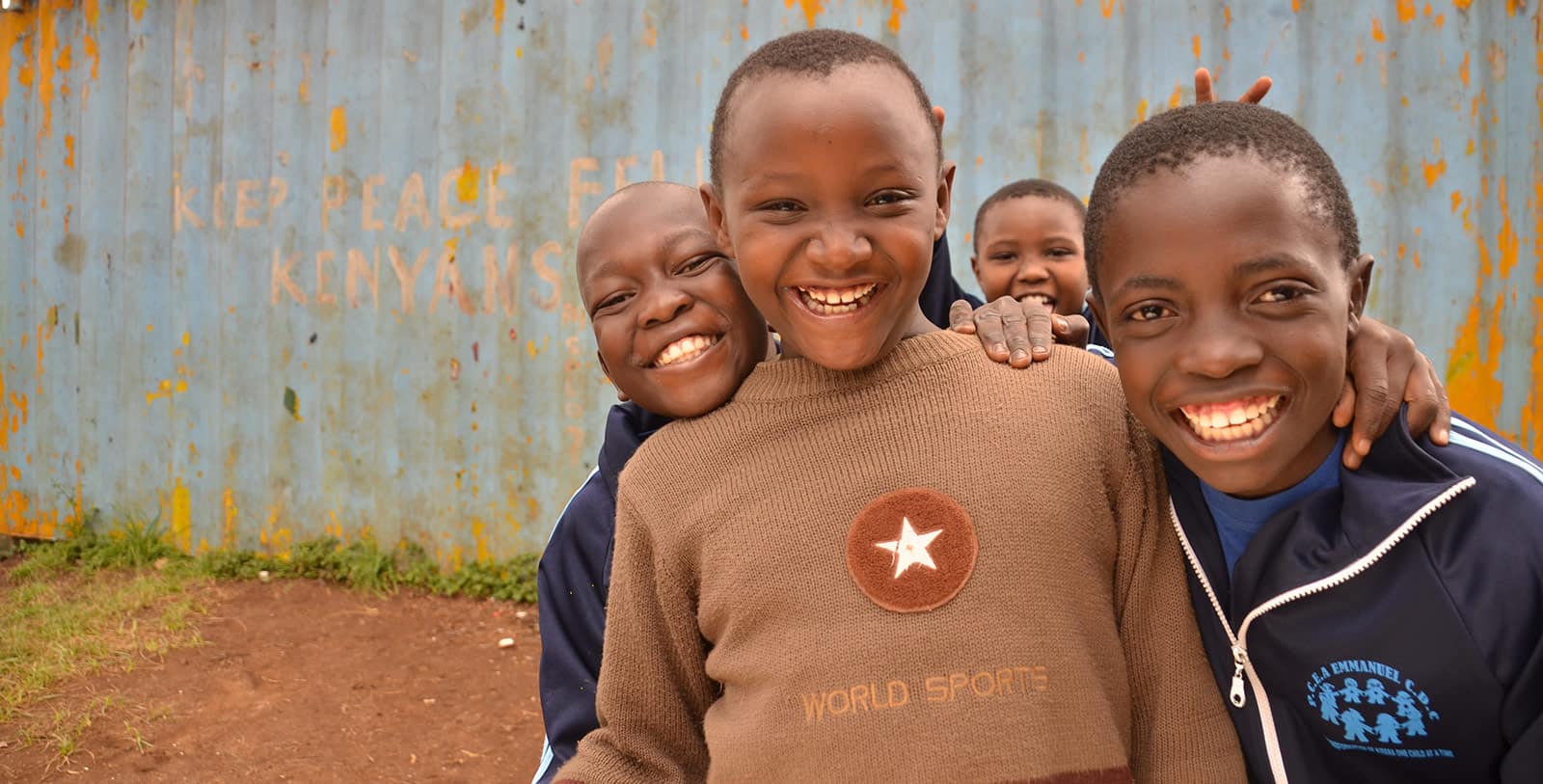More than 9 million children around the world are enrolled in some sort of child sponsorship program. And more than $3.2 billion go into these sponsorship programs every year. Which must mean that child sponsorship works, right?

That’s the exact question Dr. Bruce Wydick, professor for the Department of Economics at the University of San Francisco, asked … and he was surprised to learn that almost no in-depth research into international child sponsorship had been conducted:
“Given the number of individuals involved in child sponsorship relationships and the billions of dollars committed to them, it is surprising that almost no research exists that evaluates the impact of these programs.”
But that has changed now. The results of Dr. Wydick’s extensive research will be published in the April 2013 issue of the prestigious Journal of Political Economy, a leading economics journal. And the results are quite exciting.
To wrap it all up in a pretty bow, the results of the research show:
“. . . that children who participated in Compassion’s holistic child development through sponsorship program stayed in school longer, were more likely to have salaried or white-collar employment and were more likely to be leaders in their communities and churches than their peers who did not participate in the program.”
What Was the Study?
In 2008, Dr. Wydick, along with two colleagues, set out to explore the effectiveness of international child sponsorship. They envisioned a comparative look at several child sponsorship organizations, but we were the only organization that agreed to participate.
We did so because our mission statement is “Releasing children from poverty in Jesus’ name.”
Not temporarily relieving children from poverty.
And not helping children survive inside of poverty.
It’s releasing.
We had to raise our hand.
Because we were the only organization to accept the invitation, Wydick’s research team changed its original vision of comparing sponsorship programs. They decided to focus on researching adult life outcomes of former participants in our program against the outcomes of those who were not part of our program.
Is there a difference between adults who grew up in poverty and went through our program and adults who did not?
How Was the Study Conducted?
The research focused on six nations where we provided child sponsorship between 1980 and 1992.
That time period was chosen because children enrolled in our sponsorship program during that time frame would be adults when the research was conducted between 2008 and 2010.
The research studied the adult life outcomes of 10,144 individuals, including:
- 1,860 former Compassion beneficiaries
- 3,704 unsponsored siblings
- 2,136 families in the same communities but who had no family members enrolled in Compassion’s program
- 2,444 individuals from similar nearby villages that didn’t offer Compassion programs
The Findings
EDUCATION
The research found that former Compassion beneficiaries stayed in school longer than their non-sponsored peers.
-
- Former Compassion beneficiaries stayed in school 1 to 1.5 years longer than their non-sponsored peers. (In Uganda, the numbers were much higher — 2.4 years.) An extra year of schooling could have long-lasting impact on a child’s future employment possibilities as an adult.
-
- Former Compassion beneficiaries were 27 to 40 percent more likely to finish secondary education than those who were not enrolled in the Child Sponsorship Program.
- Former Compassion beneficiaries were 50 to 80 percent more likely to complete a university education than non-sponsored children.
When asked which component of Compassion’s program was most beneficial, the most common answer given by former Compassion beneficiaries was “educational support” (38.5 percent). The second-most common response related to “spiritual or character development” (29.4 percent).
Dr. Wydick refers to Compassion’s Child Sponsorship Program as “the great equalizer” in that it levels the playing field for children seeking an education in the developing world. In countries where there is a greater need or where children face greater obstacles to achieving an education, Compassion tends to have a greater impact.
EMPLOYMENT
The research found that, as adults, former Compassion beneficiaries were more likely to attain salaried/white-collar jobs than their non-sponsored peers.
-
- As adults, former Compassion beneficiaries were 14 to 18 percent more likely to attain salaried employment than their non-sponsored peers.
- As adults, former Compassion beneficiaries were roughly 35 percent more likely to secure white-collar employment than their non-sponsored peers.
LEADERSHIP
The research found that, as adults, former Compassion beneficiaries were more likely to become leaders in their communities and churches.
-
- As adults, former Compassion beneficiaries were 30 to 75 percent more likely to become community leaders than their non-sponsored peers.
- As adults, former Compassion beneficiaries children were 40 to 70 percent more likely to become church leaders than their non-sponsored peers.
A Note on Comparisons
To be clear, this study does not present a comparison of our program to other sponsorship organizations. Nor does it make any claims that our program is better than any other child sponsorship offering.
In fact, the researchers say it would be difficult to compare our Child Sponsorship Program to other organizations.
What Does This Mean for You?
No matter who you are — sponsor, donor, non-sponsor, volunteer — you now have independent, empirical research validating Compassion’s Christian, holistic, child-focused, one-to-one Child Sponsorship Program.
You can now confidently say, “It Works!”







16 Comments |Add a comment
I don’t see anywhere in your website a link to where I can sponsor a child. I would like to sponsor a child in a Spanish speaking country. I would like a boy or girl child about 6 years old.
Gina, thank you so much for your desire to sponsor a child! I would be happy to get a sponsorship set up for you. Would you kindly send us an email at [email protected] with all of the information you provided here, as well as your mailing address and phone number? We will continue the conversation there. We are so excited to help you get started sponsoring!
Let us reach the challenged/vulnerable children with love
Empathy should be the basis for our love-walk. Some of my family members in Nigeria had been involved in child sponsorship programs through our outreaches targeted to vulnerable children & girl child literacy campaigns and empowerment trainings with great rewards until the project was truncated by some persons. The children were usually products of child labour, sex market, & other social vices. What a wonderful world.
I sponsor a little girl in Ethiopa and she has 2 younger brothers. How are they being helped? Do they get to go to school too?
i believe child sponsorship does make a difference. Anyway, its the least anyone can do in this day and age/
Child Sponsorship is one of the best strategy to help kids sent to school. Seeing them learn and grow as professionals is something very rewarding most specially to those people with compassionate heart. I wish more people would realize the impact they can bring to these kids.
I think the most valuable part of Compassion’s work will not be seen this side of Heaven
Most excellent! ‘Course, we already knew that it works, but it’s nice to have this new support. Great post, Brianne!
Having been blessed with the opportunity to have a current LDP student stay at our home and speak at our church, I know that Compassion works! But having the information provided throught this study will help people who might be a little skeptical to see that this is an amazing program that does what it says ‘releasing children from poverty in Jesus’ name’!
at crazy as it sounds, I wasn’t skeptical, I knew it would be a blessing to the kids I sponsored and myself and it has been beyond and words and with words: AWESOME 😉 But I can testify child sponsorship with Compassion works b/c one of my sponsor children no longer needs compassion’s support and I hope that was because they were able to buy a cow with a family gift I sent, if not it still helped and I hope she reaches her dream of becoming a pastor or whatever the Lord leads her to do ; )
Will the full report be available in PDF format or available for online reading?
Hi Chris! You can download a pdf here: https://www.compassion.com/press/wydick-research.htm
Jacquie-I am super impressed that CI was able to get the journal to let you distribute the article for free! As you can tell from my previous response that practically never happens with journals!
That’s really encouraging to hear Becky, I did not know that. Thank you for your input and expertise!!
I am a researcher, and unfortunately, from experience, I know that just about every journal has copyright restrictions that prohibit an organization or individual from paying for an article and then disseminating it further. Yes, there are exceptions, such as research funded by the NIH (US govt source) must be available for free within 12 months of being published. I checked the journal’s website, and as expected, the journal requires individuals or institutions to pay for access to any article. As such, CI is prohibited from obtaining the article and publishing it on their website for others to read. Right now the article is listed as ‘forthcoming’ which essentially means that the article finished the peer-review process and was accepted to the journal although the full article is not out in print yet. I do not know what the funding source was, but if it was the NIH (or another organization with a similar open access policy) the journal has 12 months from when the article is published until it is required to make a copy available for free in PubMed Central.
The abstract is currently available here (about halfway down the page):
http://press.uchicago.edu/journals/jpe/forthcoming.html?journal=jpe
Please note that it will disappear from that webpage and appear on another webpage the journal has once it is out in print.